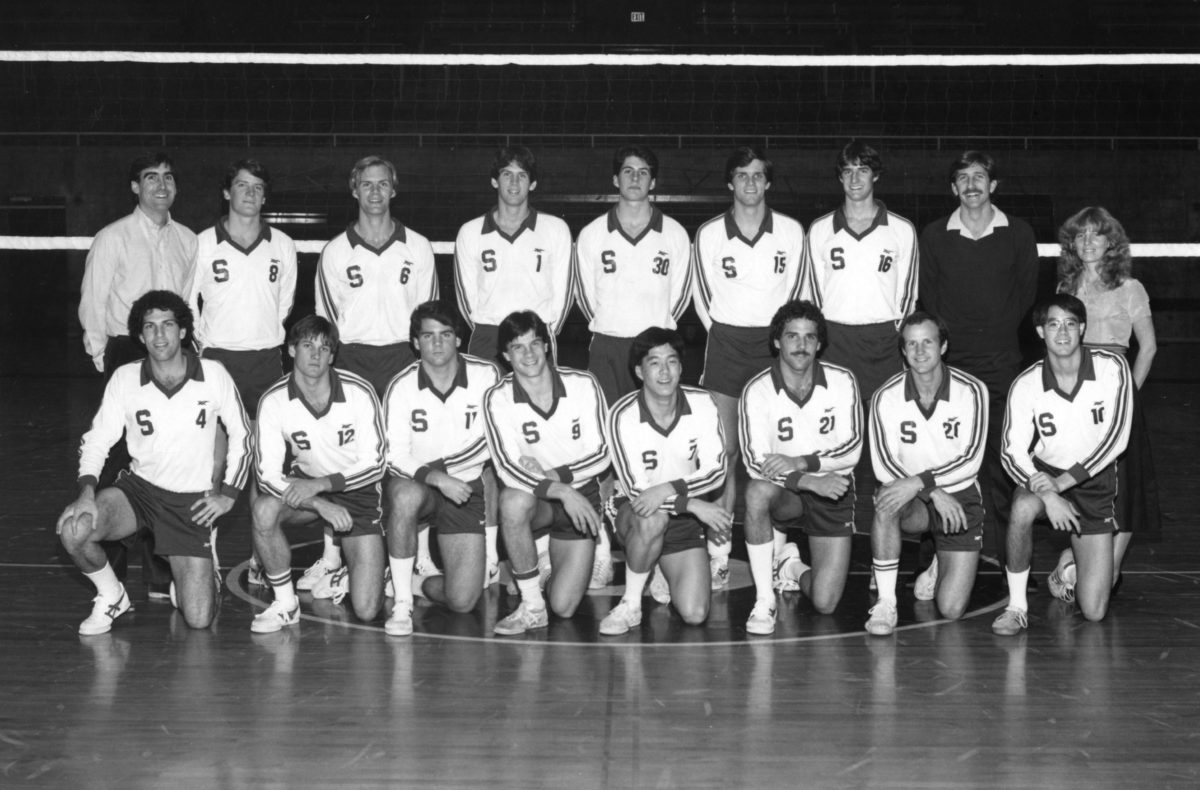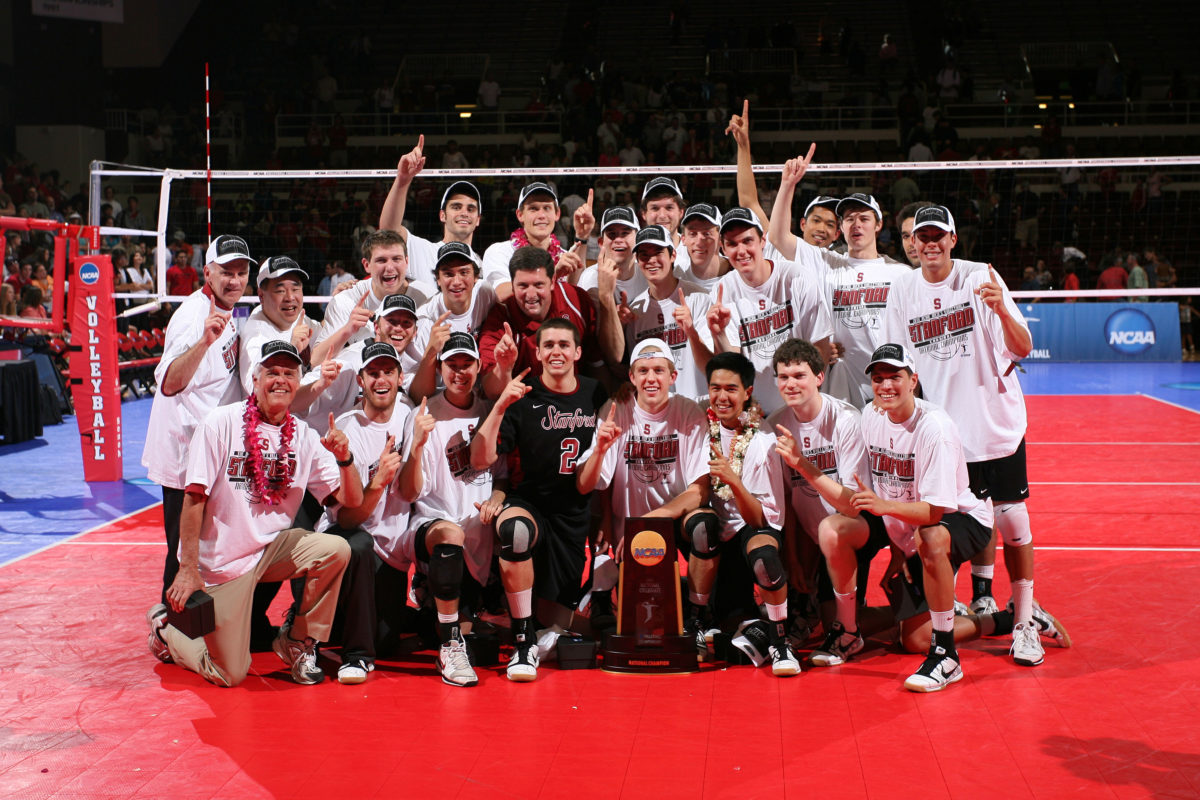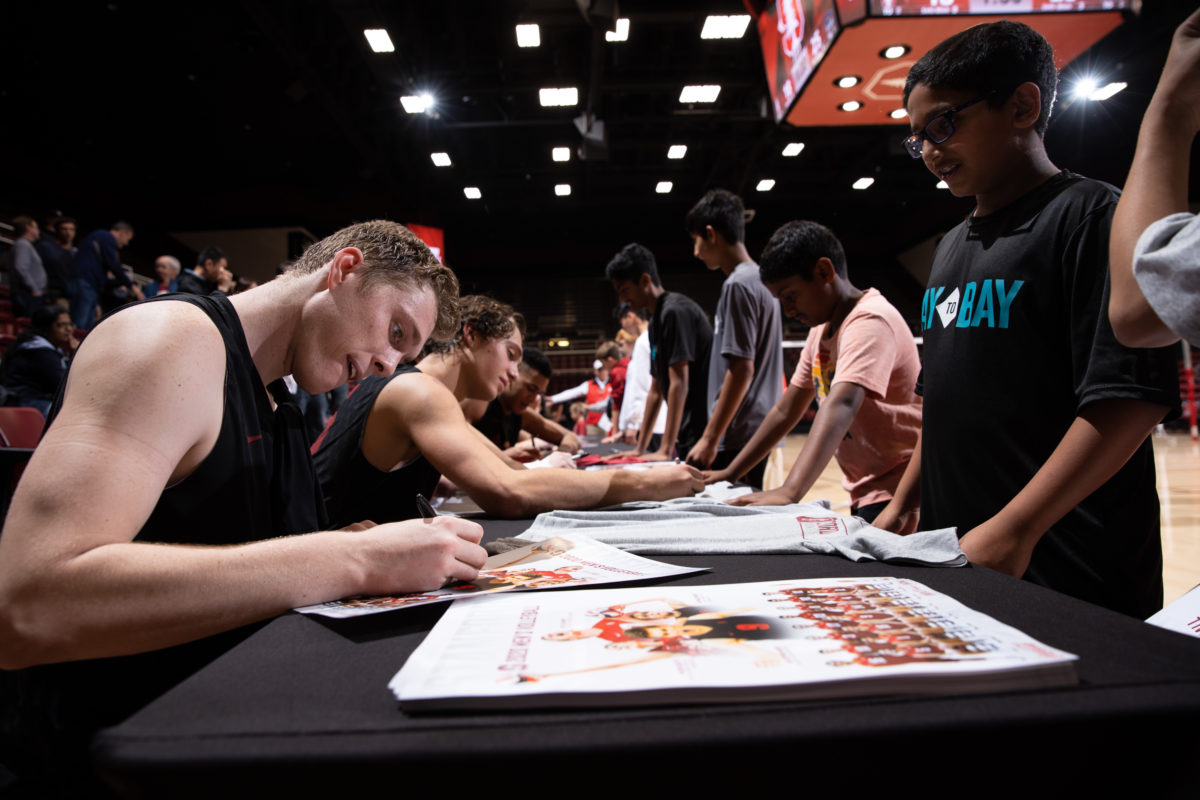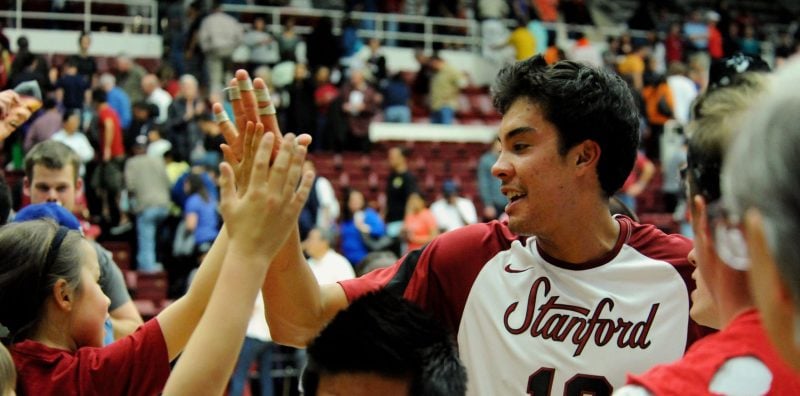“Game Point” is a series of articles documenting the reactions of men’s volleyball players and alumni to the July 8 announcement that Stanford Athletics would discontinue 11 varsity programs, including the men’s volleyball team, following the 2020-21 season. The articles endeavor to share efforts to save the team and the broader implications — collegiately, nationally and internationally — of the abrupt decision. Part one on initial reactions and the petition can be accessed here.
The new documentary, “Match Point: The Rise of Boys and Men’s Volleyball,” details the recent boom in volleyball both domestically and internationally, and Stanford’s strong presence in the men’s side of the sport is apparent from the film’s opening scene.
The movie begins with Team USA lined up courtside. The camera pans leftward until settling upon libero Erik Shoji ’12 as he stands in the United States’ starting line up against Japan.
The documentary goes on to highlight coaches and players from across the nation, reflecting on the unprecedented rise of participation in the men’s game. The short film, written and filmed by Ball State University students, also includes clips of NCAA games from just two venues: Ball State’s Worthen Arena and Stanford’s Maples Pavilion.
To further drive the Cardinal connection home, of the two Olympic team members featured in the interviews, one is setter Kawika Shoji ’10, Erik’s older brother.
“It’s great to see that there are new and upcoming college programs making themselves known, recruiting more athletes, getting more boys into the college game,” Kawika said in the documentary. “It’s fantastic.”
The film premiered on June 25, but evidently, the Stanford administration did not see it.
Blocked Collegiate Growth
Less than two weeks after the film’s release, the University announced that it would cut men’s volleyball following the 2020-21 season. Among the reasons cited in the FAQ were lacking “sponsorship of the sport at the NCAA Division I level” and “national youth and postgraduate participation in the sport.”
“The implications for the rest of the country for men’s volleyball are massive from this decision,” said setter James Shaw ’16. “I doubt that [administration] realized that when they made this decision. I doubt that they really understood how much growth there is in the sport — at a young person level and also worldwide.”
Stanford’s announcement also notes that less than 9% of NCAA Division I programs sponsor men’s volleyball. But Shaw and other players past, present and future see this decision — and citing this particular statistic — as “very short sighted.”
“I don’t think they really had the full facts in front of them,” Shaw said. “That’s the problem with our sport; there are just not enough powerful people in those types of rooms to bring that opinion to the forefront. So that’s where we need to show that there are enough people like that, who are willing to support and back a program like this, because it’s growing and because there’s potential in the sport.”
“I absolutely do think there will be larger ripples from this,” Erik said. “It’s unfortunate to understand that Stanford probably did not look at the growth of men’s volleyball, how much momentum it has and how big of an effect this decision is going to have down the road.”
University athletics representatives did not respond for comment.
Although there are currently only 22 Division I men’s volleyball programs, men’s volleyball is the fastest-growing NCAA sport over the last decade.
Factoring in NCAA Division II, NCAA Division III, NAIA and California Community College Athletic Association teams, there are over 200 collegiate men’s volleyball programs nationwide.
The NCAA also recently announced that it would mandate an additional conference, the Southern Interscholastic Athletic Conference (SIAC), beginning in the 2020-21 school year. The SIAC includes six historically black colleges and universities, reflecting the growing racial diversity in the sport.
Stanford, however, cited “diversity of our student-athlete population” as a criterion contributing to decisions about which programs to cut.
In response, Save Stanford Men’s Volleyball — the alumni coalition fighting to defend the program — wrote on its website, “By eliminating the Men’s Volleyball program at the same time that the sport is dramatically expanding its reach and inclusiveness, Stanford is undercutting important progress in the diversity of the sport and forfeiting an opportunity to lead.”
Although Stanford’s decision to terminate the program appears on the surface to be a localized change, alumni and players fear the broader ramifications.
“This could totally wipe out our sport at the DI level completely,” said rising senior opposite Jaylen Jasper. “There are only 22 Division I schools that have men’s volleyball; now that it’s going to be an even smaller number. [Schools] aren’t going to want to add a team because there aren’t many. One, [Stanford], just got dropped that was a major historical program. It’s a major hindrance for the growth of our sport.”
“Volleyball is the fastest growing sport in the nation, one of the most popular worldwide,” said incoming freshman outside hitter Kupono Browne. “Here we have an elite institution that is one of the first to take a step in the wrong direction. This could potentially send unparalleled waves through the collegiate community.”
Brad Lawson ’12, a three-time AVCA first-team All-American outside hitter, said that following the July 8 announcement, alumni gathered on a Zoom call and discussed the implications of the discontinuation for the broader collegiate volleyball community. Lawson recalled one alumnus saying that he had already heard of a few other colleges beginning to have discussions about cutting their varsity men’s volleyball programs.
“If other schools are looking for an excuse to get rid of their men’s volleyball team, okay, ‘Stanford just did it. Now the door’s open for us,’” Lawson said. “There’s a domino effect. I’m really, really worried about that.”
“Who could be next?” Browne asked.
“It’s really hard to speculate, but I think if schools see if a ‘Stanford’ could cut men’s volleyball — one of the most successful academic and athletic programs in the nation and in the world — then ‘why can’t we and save a couple hundreds of thousands of dollars down the road?’” Erik said. “I pray to God that it does not and we can get this back up and running as quick as possible. But if we look in the long run, if this decision isn’t reversed, then Stanford could play a very large part in, honestly, just killing the sport of volleyball.”
Because of its potential to spark the “gradual disappearance of collegiate men’s volleyball,” as Browne put it, players and alumni fear that Stanford’s decision could be a turning point in NCAA volleyball.
“It’s pretty scary, kind of tense,” said Chris McLachlin ’68, M.Ed. ’70. “It’s a real slippery slope right now.”
McLachlin has been part of the Stanford men’s volleyball program as a player, coach and parent. He kept the program alive as a club in the 1960’s, which paved the way for the University to gain varsity status once the NCAA began mandating the sport.

High (School) Scoring
In many ways, recent national growth in collegiate volleyball would not be possible without a similar boom in the sport at the high school and club levels.
Boys’ volleyball is the fastest-growing high school team sport in the nation and has expanded by 22% over the last five years alone. Meanwhile, participation in football has decreased by 9% over the same period.
Lawson, who now coaches high school after playing three seasons professionally in Europe, has seen this growth firsthand.
“The trend is favoring the expansion,” he said of boys’ volleyball. “I’ve seen, especially in Southern California, how competitive it is and how many teams there are. There’s just such a level of interest.”
He noted that many high school and club games needed to be moved to collegiate venues to accommodate high demand from spectators.
Such demand contradicts the purported lack of “local and national fan interest in the sport” that Stanford cited in its FAQ as a reason for men’s volleyball’s loss of varsity status.
“It’s a growing sport at the youth level,” McLachlin said of boys’ volleyball. “It’s getting bigger and bigger, mostly because kids know they have a college to go to. Take away one of the premier programs, and it could have a big impact on that youth sport organization. That would be tragic, to say the least.”
Between his coaching stints at Stanford in the 1960s and 2010s, McLachlin spent nearly four decades as athletic director, coach, counselor and teacher at his alma mater, Punahou School. The Honolulu school spans kindergarten through 12th grade.
During his tenure, McLachlin interacted with thousands of youth athletes. He coached the boys’ volleyball team to 11 state titles and the boys’ basketball team to three. Among the players on his 1978-79 state championship basketball team was Barack Obama. The two reunited at the NCAA men’s volleyball championship celebration at the White House in 2010 following Stanford’s victory.

California and Hawai’i have long had deeply rooted volleyball histories, but the sport is also expanding to new corners of the country and globe. Twenty-nine states now mandate boys’ high school volleyball; the most recent addition was in Colorado just last year. According to “Match Point,” further initiatives and pilots are underway in 18 more states.
Over 63,000 boys currently play high school volleyball nationwide — if the sport’s upward trend continues, it is projected that over 100,000 boys will be playing by 2026.
Jasper was one such child that benefited from boys’ volleyball’s recent geographic expansion. Growing up in Maryland, he said volleyball was often labeled a “girl’s sport,” but he stuck with it despite the fact that his public high school did not offer a team.
Since his childhood, however, Jasper has seen the sport grow tremendously in the Mid-Atlantic region.
“A lot more kids are trying out,” he said. “The clubs are getting bigger.”
And the popular perception is changing, too. Jasper also noted that it is now more common to see boys and men playing recreational volleyball on his trips home.
Back in the Bay Area, Jasper has also seen the boom in high school club volleyball. Stanford men’s volleyball’s volunteer assistant coach Matt Houlihan also runs Bay to Bay, a San Jose based boys-only volleyball club.
Jaylen fondly recalled Bay to Bay players attending Stanford games and serving as ball boys.
“After the games they would line up to get our autographs, which I always thought was just a cute gesture,” Jasper said. “I realized shortly after that it’s because they look up to us and hope to be where we are one day.”
Jasper became a mentor for many of the boys when he served as assistant coach at the club last summer.
“They asked me about Stanford and how I liked it and how I got there,” the three-time AVCA All-American Honorable Mention said of the Bay to Bay parents and players. “They would tell me how it’s their dream to play on the Stanford men’s volleyball team so badly.”

“They all follow me on Instagram, and I still keep in touch with the kids that were on the team that I coached,” Jasper said. “They are some of the funniest and nicest kids I have ever met, and that is how most volleyball clubs are.”
In fact, as a two-sport athlete in high school, Jasper chose to pursue volleyball instead of basketball partly because of the supportive community he found in club volleyball.
“If there was somebody who understood what the volleyball community felt like, I think [Stanford’s cancellation] would have been a completely different decision,” he said. “I played basketball for 10 years, and I probably only knew the kids on my team and a few of the kids on the high school teams around me. But as soon as I started playing volleyball, I had friends in California, in Florida, in the Midwest — all over the country. I knew everyone’s parents. I would go to club tournaments and play against my friends’ club teams, and it was like a big reunion. I never had that with basketball.”
Despite graduating eight years ago, Lawson still feels that same sense of community.
“We were such a tight-knit group,” he said of his teammates. “We still have a group text, and we keep in touch. Whenever we’re close enough — whenever we’re visiting LA or New York or wherever it might be where some of our teammates are — we always get together.”
Recently, however, those meetings have been virtual gatherings to strategize how to save the program that shaped them so heavily. Despite the uncertainty, many players expressed immense gratitude for the sport they love.
“Volleyball carried me to an elite education, unmatched leadership development and really a lifelong family of my own at Stanford,” Lawson said. “I’ve always found that the story of us Hawai’i boys making it into top universities and beyond via volleyball resonates with people. Cutting this and other sports programs is denying the chance for this to reoccur in the future, I really feel that to be true. Without volleyball, combined with obviously doing well academically in high school, some of us wouldn’t have made it to Stanford.”
He continued, “If we cut volleyball, we deny so many up-and-coming, talented kids — who are also smart — the opportunity to go to an elite institution and become leaders, better men, better athletes.”
Contact Cybele Zhang at cybelez ‘at’ stanford.edu.
